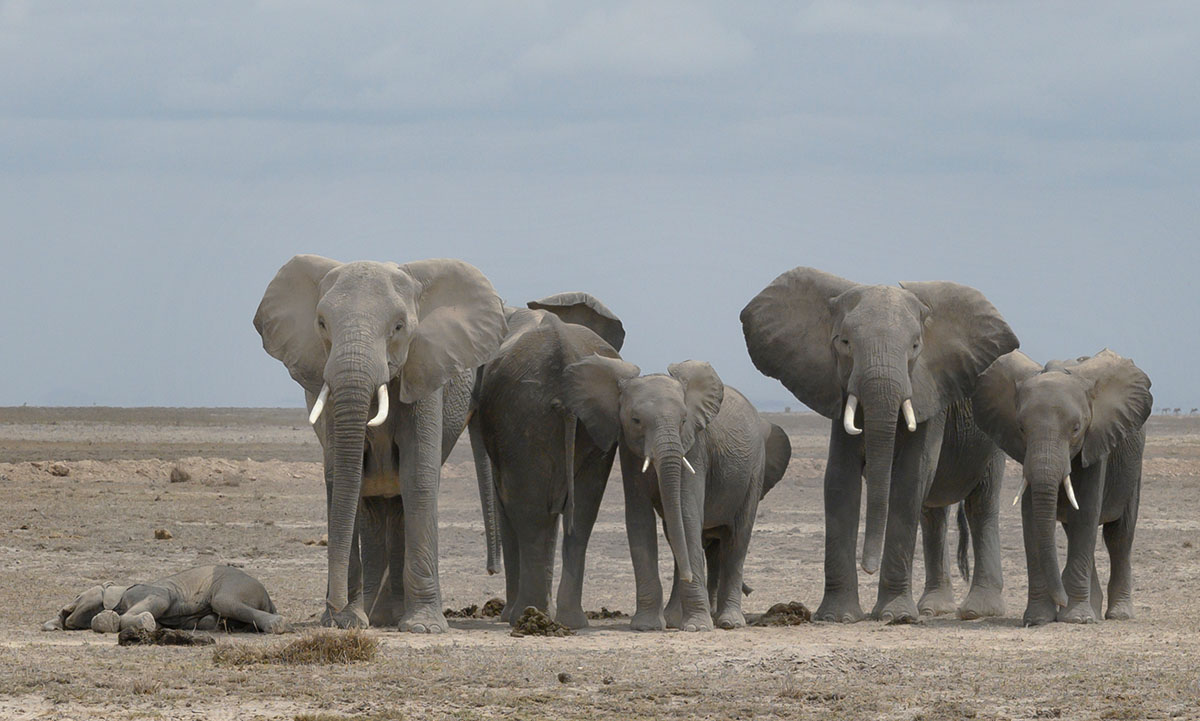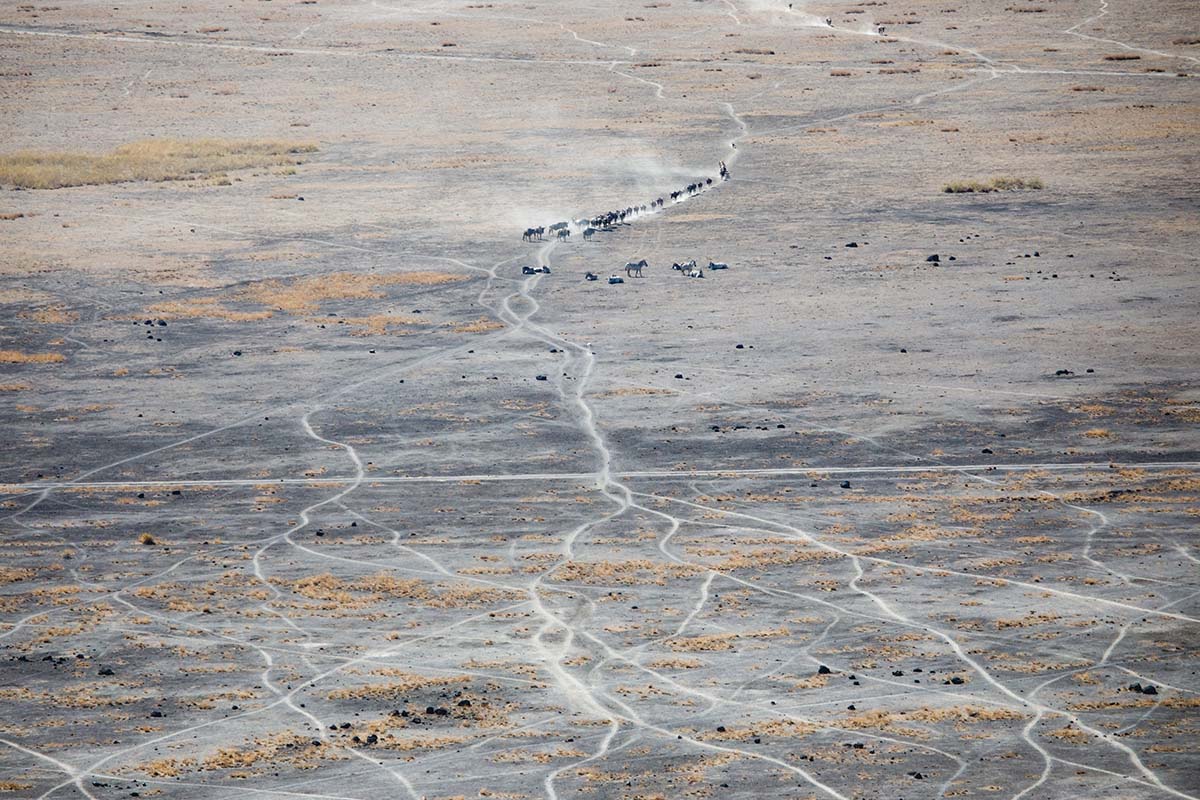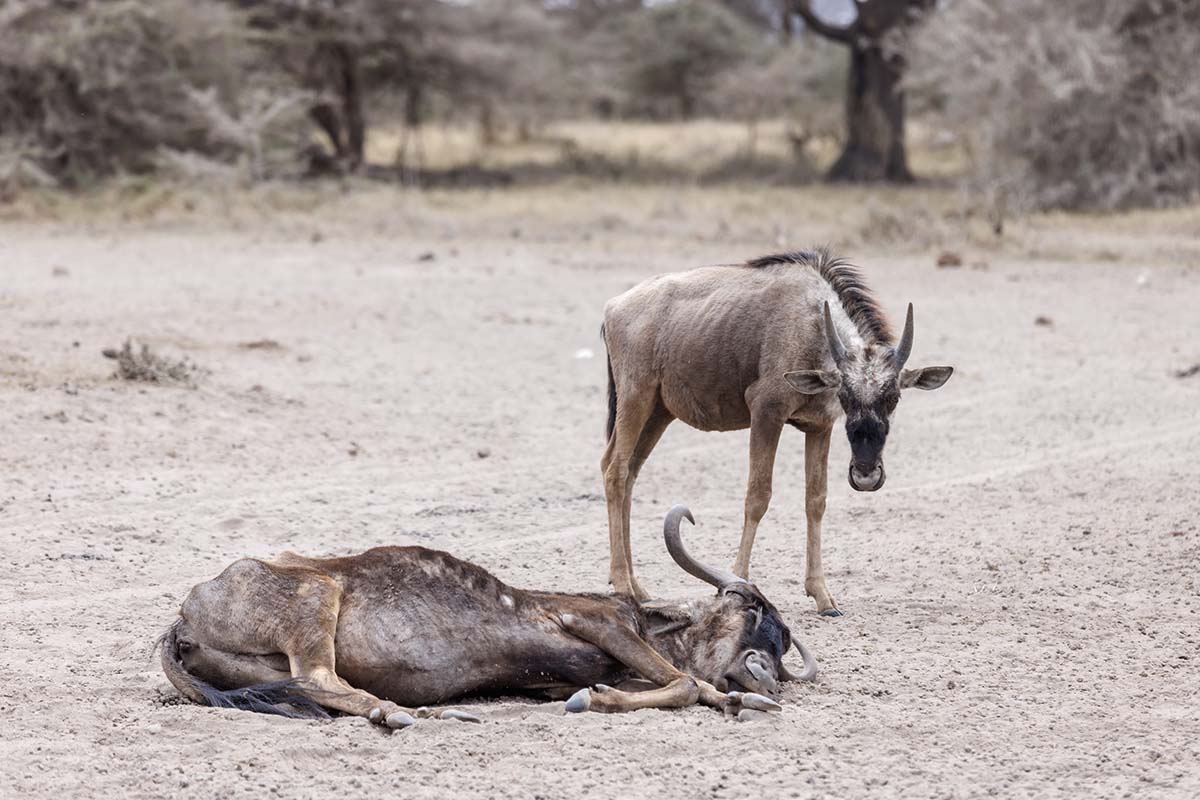There is a commotion on the bone-dry Amboseli lakebed, as a herd of elephants gathers around a small shape. From a distance, it looks like the celebration that follows a birth. Getting closer, it is clear that it is the opposite. The small shape is an elephant calf in trouble.

Starved and dehydrated, the calf is too weak to stand, and family members are taking turns trying to lift it to its feet. But there is nothing the other elephants can do, and eventually the calf goes still, the life drained from its small body. The herd mourns but must slowly move off, leaving behind another victim of the drought that is currently sweeping the Greater Amboseli ecosystem.
The “long rains” that we should have received earlier this year largely failed, with some areas of the ecosystem only receiving 15% of the rains expected.
The impact has been—and continues to be—devastating.
Without rain, grass cannot grow. The Amboseli swamps, normally a last refuge during dry times, have been stripped of vegetation. Countless animals have already died of starvation, many ironically within reach of a limitless supply of drinking water.
The remaining food is in places that are farthest from water, leaving animals with a terrible decision. They can use what little energy they have to walk to these far-off areas, knowing that they will have to trek back for water. Or they can stay close to water, but risk starvation.

Those who decide to make the life-threatening journey are venturing much further into the fringes of the ecosystem, and in some cases beyond the protection of the 'safe zone' that have been created by Big Life’s anti-poaching rangers. Humans are hungry, too, and poachers are lying in wait, taking advantage of the weakened animals who are now so easy to kill. Compared to 2021, poaching of wildlife for bushmeat has doubled in July and August.
With natural resources under such tremendous stress, conflict over what remains is huge. Farmers’ crops are a magnet for elephants and other wildlife, some of whom are desperate enough to take the shock of Big Life’s electric crop-protection fence to break through to reach sustenance on the other side.
Community waterpoints are straining under the pressure of the need to deliver water for livestock as well as the wildlife that is lining up behind. If elephants arrive at a trough without water, they will break tanks and pipes to get at it, exacerbating the problem.
Livestock are suffering in the same ways. Weak and easily separated from their herds while walking to and from grazing areas, they become easy pickings for lions, hyenas, and other predators.
Stress levels are high for all, and Big Life’s rangers are carrying a huge burden on their shoulders.
Droughts are natural in these semi-arid systems, but the impacts we are seeing are certainly not. Human-induced climate change and overgrazing by livestock has left this landscape extremely vulnerable.
We have not seen anything like this since 2009. By the time that drought broke, at least 300 elephants were dead and over three-quarters of the wildebeest and zebra populations had been wiped out. Things are not that bad, yet. But we are heading in that direction and each day, Big Life’s rangers are counting the increasing toll of the weak and the dead.

Ordinarily the ecosystem’s "short rains" would arrive in about six weeks. But there is no guarantee when the rains will arrive or if they come at all. For now, each passing day is a struggle for survival.
We cannot save all of the animals, but what we can do is try to keep the strongest alive, for they will be the ones to regrow the population once the drought is over. This presents a daunting challenge, but we stand a chance with your help.
A generous donor provided funds for early action, including programs to support our partner communities who are also suffering. This same funding will support provision of water to animals that are traveling to distant grazing areas.
But now, with the ecosystem rapidly failing, we need to do more. Big Life has created an emergency plan to respond to this urgent crisis including:
- Deploying rangers outside of Big Life’s normal patrol range to stop poachers and illegal killings as animals are now travelling to distant areas in search of food and water.
- Creating two additional temporary ranger “rapid response units” that will be on the move day and night responding to drought-related emergencies like poaching and conflict threats and animal rescues.
- Increasing Big Life’s Predator Compensation Fund payments for the community after rapidly escalating verified livestock predation incidents - the only defense against retaliatory lion killings.
- Establishing wildlife feeding points in three strategic locations, where Big Life believes we can have impact, to boost the chances of survival for some wildlife populations.
Our emergency plan hinges on funding, and due to unexpected global inflation, the cost of our operations has skyrocketed since the start of the year. Core expenses like fuel for ranger vehicles have risen 43%. Ranger rations have jumped 55%. PCF payouts have increased by 60%. Fence breakage repairs and maintenance cost 40% more. And new wildlife feeding points will add an additional $35,000 to our already stretched budget.

It is heartbreaking to watch an ecosystem, its wildlife, and the local people suffer tremendously. But we know the rains will come again, and we are confident in our programs which are designed to enable long-term survival of the ecosystem. But until then, Big Life will do what we always do – we will face the challenge head-on.
We only ask for support when there is truly a need, and right now is one of those urgent times. Please help us be a lifeline for those we can protect and save.
